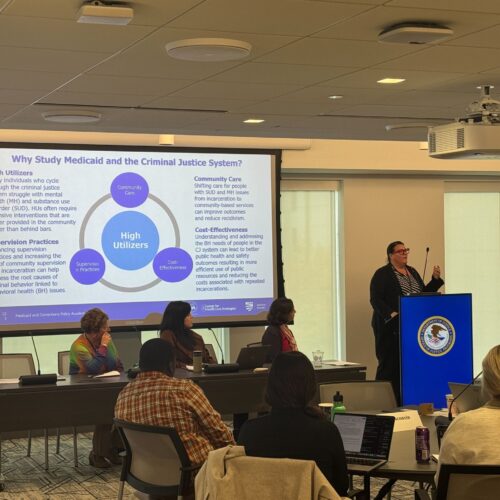Expanding Access to Telehealth through Community Supervision and Health Care Partnerships
People on community supervision often face multiple barriers to accessing health care while also experiencing higher rates of chronic diseases, behavioral health conditions, and infectious diseases compared to the general population. Recent developments, including a Medicaid demonstration opportunity designed to improve care transitions for people in reentry, offer community supervision professionals more options for connecting people with needed care. To fully take advantage, community supervision agencies will need to partner with local health care providers that offer Medicaid-covered telehealth services for primary, behavioral, and specialty care. This guide outlines five practical steps community supervision leaders can take to engage health care providers and expand access to these services.
Introduction
People on community supervision often face multiple barriers to accessing health care while also experiencing higher rates of chronic diseases, behavioral health conditions, and infectious diseases compared to the general population.1 To address these disparities, policymakers over the past several years have worked to increase health care access, particularly as people reenter their communities, through eligibility expansion for Medicaid2 and greater access to telehealth services. The latest of these efforts includes a new Medicaid demonstration opportunity designed to improve care transitions for people in reentry.3
For community supervision professionals, this new opportunity, coupled with telehealth added to the types of services that can be covered by Medicaid, means more options for connecting people with needed care. To fully take advantage, however, community supervision agencies will need to partner with local health care providers that offer Medicaid-covered telehealth services for primary, behavioral, and specialty care. This guide outlines five practical steps community supervision leaders can take to engage health care providers and expand access to these services.
What Is Telehealth? Telehealth refers to the facilitation of health care services through telecommunications and digital communication strategies.4 In this guide, the term specifically refers to real-time audio and/or video visits, in which providers offer care to patients remotely through phone calls or video-conferencing technology.5
How Can Telehealth Benefit People on Community Supervision? As states enroll more people leaving jails and prisons in Medicaid,6 telehealth offers community supervision agencies another strategy to expand access to care. It can reduce barriers to care, such as work-related time constraints, transportation, and child or elder care responsibilities. Audio-only services under telehealth are an important option for people who lack access to the internet, have transportation barriers, live in rural areas, and are managing competing priorities, including work and community supervision requirements.7 Importantly, research indicates that some telehealth services can be as effective as traditional in-person visits for behavioral health needs.8
How Does Medicaid Cover Telehealth Services? Medicaid allows states flexibility to determine which services may be delivered via telehealth, what settings and sites of care these services can be delivered in, who may deliver these services, which specific Medicaid populations and geographic areas can be served, and payment rates for providers.9 The COVID-19 pandemic accelerated the use of telehealth in Medicaid and the health care system broadly for physical and mental health services.10 While Medicaid coverage for telehealth services varies from state to state, all states now cover behavioral health care and primary care via telehealth under their Medicaid programs.11 Additionally, many states have made some telehealth policies from the COVID-19 public health emergency permanent. States continue to take different approaches related to reimbursement, licensure, and modalities that ultimately impact how care is delivered.12
Five Steps to Building or Expanding Partnerships with Telehealth Providers
Community supervision agencies can play an important role in prioritizing access to telehealth services for people on community supervision, but they cannot do this work alone. Partnerships with health care providers can lessen pressure for community supervision staff to search and find health care and treatment slots for people on their caseloads. Health care providers can also support the goals of supervision agencies and help address risks of recidivism by offering services to meet the health needs of people in reentry, reduce the risk for substance use, and ensure engagement in specific treatment services, which impacts a person’s ability to maintain community supervision terms.
Agency leaders can consider different partnership models depending on the interest of the health care partner and the capacity of the supervision agency. These models can range from simply providing information about health care providers to people on supervision to working together to create spaces and offer technology to make telehealth visits more accessible. It can also include establishing more formal contractual and referral networks to ensure people on community supervision have access to telehealth.
Step 1: Identify a priority population and their needs.
Nearly all people on community supervision can benefit from increased access to health care services through telehealth. Partnerships with telehealth providers can include services for all individuals on supervision. However, if there are limited resources, community supervision agencies may choose to focus on building partnerships that prioritize a subset of the population based on certain needs.
Criteria for identifying a priority population may include:
- Serious behavioral health conditions, including mental health and substance use disorders
- Behavioral health treatment as a condition of their probation or parole
- Difficulty accessing transportation
- Multiple or complex chronic health conditions
- Medium to high criminogenic risks
Understanding the priority population allows community supervision staff to focus their time and efforts on building relationships with the health care providers and community partners best equipped to meet the population’s specific needs.
Step 2: Determine the most appropriate partners based on the priority population’s needs.
There are important factors to consider when determining a partner to help expand telehealth options for people on community supervision. Agency leaders should ensure that any new or existing health care partner providing telehealth services are covered by Medicaid. The partner must also be able to realistically meet the priority population’s health needs and supervision requirements. It is helpful to determine whether a health care provider offers audio-only services or relies strictly on video visits, which can create additional barriers since video requires access to the internet.13
Leveraging existing partnerships: Community supervision agencies may have existing contractual or formal partnerships with physical and behavioral health care providers who offer telehealth options. Agency leaders can start any effort to increase telehealth access by exploring the relationships they already have and determining if their telehealth options can fully meet the needs of their community supervision or priority population.
Developing new partnerships: To determine potential new partners, community supervision leaders can start by considering providers who already have experience or the desire to work with people on community supervision. Staff can research local physical and behavioral health care providers, particularly federally qualified health centers, which often provide telehealth services spanning behavioral health and primary care, and can facilitate connections to specialty care. These partners will still need to ensure they can fully meet the needs of the community supervision or priority population.
Step 3: Identify ways that the community supervision agency can support telehealth expansion.
The elements of a successful telehealth visit include access to technology (such as a laptop, tablet, or smart phone for video, or a telephone for audio-only visits); access to the internet, preferably broadband; digital literacy, or the ability to use technology effectively; an easy-to-use patient interface; and a private space for both the patient and the provider. When seeking to ensure people on supervision have greater access to telehealth, agency leaders may also have to assess the agency’s internal capacity and identify ways to support successful telehealth visits. Leaders can do this by:
Identifying the technology needs of people on supervision and directing them to community programs or resources that can offer assistance. Technology is critical to effectively delivering telehealth, but it can be a barrier if people do not have access to things like phone service or the internet. One way that supervision leaders can support telehealth visits is by connecting people to local and federal programs that offer phones, internet, and computer access. These resources can be found through local libraries for computer/internet services or through the Affordable Connectivity Program, a Federal Communications Commission benefit program for broadband access.14
Creating safe and private physical spaces for people to attend telehealth visits, either by offering private space in the agency’s offices or identifying community organizations that would allow people to use their space for this purpose. These spaces can be created by utilizing offices or rooms that are less frequented or building enclosed booths within larger communal spaces to offer private dedicated space.15 These spaces should also be equipped with the technology required for a telehealth visit.
Assigning and training staff to manage partnerships. A community supervision point of contact should be assigned to assist health care providers with navigating red tape and troubleshooting issues within community supervision agencies. Staff may also be needed to troubleshoot challenges in identifying appropriate clients, accessing appointments, and determining whether clients were able to attend appointments. In many community supervision agencies, this role is assigned to staff who have intensive supervision caseloads and are aware of best practices related to offering care to people in reentry with behavioral health conditions. These community supervision staff typically have received additional cognitive, behavioral health, or medical training to ensure that they are equipped to assist people in addressing their health care needs.
Step 4: Develop formal agreements to establish roles and responsibilities in the partnership.
Formal agreements, such as a memorandum of understanding, can be especially helpful for community supervision agencies that want to establish a referral system to health care providers that offer telehealth services. Stakeholders should develop formal agreements that clearly define the key roles and responsibilities of the supervision agency and the health care provider in the partnership. Having a clear, formal agreement will help ensure that the partnership is maintained despite any organizational changes and will be able to consistently facilitate continuity of care for clients. Questions to consider when developing a formal agreement include:
- Which populations are covered under the agreement?
- Who will be prioritized for the services?
- What are the specific roles and responsibilities of each partner?
- How will referrals be made?
- What is the frequency and medium of communication and reporting requirements between partners?
- What are the expectations around communication between the health care provider and community supervision agency about people who are on community supervision?
- What data will be shared and how will the data be shared?
- What are the protocols for resolving any problems?
Step 5: Conduct ongoing reviews of the partnership to measure its progress and success.
Community supervision leaders should develop a framework for measuring the success of the partnership to ensure that their priority populations are accessing telehealth services. By tracking key data, leaders can identify areas that may need improvement and make advancements over time. Metrics that agencies can consider tracking include:16
- Number of people eligible for Medicaid
- Number of people enrolled in Medicaid
- Number of appointments scheduled
- Number of appointments kept
- Engagement in telehealth services
- Retention in telehealth services
- Patient satisfaction of telehealth services
- Technical violations17
- Returns to jail/prison
Community supervision agency leaders can also work with health care providers to develop metrics that can be tracked to evaluate the outcomes of the partnerships and determine processes for quality improvements.18 A metric to track health care partnerships may include service engagements, such as number of visits and patient activation. Community supervision agencies can evaluate the outcomes of those engagements through factors such as relapse, morbidity rates, or the number of clients maintaining a medical regiment. The results of this data can influence policymakers considering ongoing funds to support health care partnerships and reduce community supervision revocations.
Endnotes
1. Laura C. Hawks, Nadine Horton, and Emily A. Wang, “The Health and Health Needs of People on Community Supervision,” The American Academy of Political and Social Science 701, no. 1 (May 2022): 172–190, https://doi.org/10.1177/00027162221119661.
2. For example, see Jocelyn Guyer, Kinda Serafi, Deborah Bachrach, and Alixandra Gould, “State Strategies for Establishing Connections to Health Care for Justice-Involved Populations: The Central Role of Medicaid,” The Commonwealth Fund, January 11, 2019,
https://www.commonwealthfund.org/publications/issue-briefs/2019/jan/state-strategies-health-care-justice-involved-role-medicaid.
3. Centers for Medicare and Medicaid Services, “Re: Opportunities to Test Transition-Related Strategies to Support Community Reentry and Improve Care Transitions for Individuals Who Are Incarcerated,” April 17, 2023, https://www.medicaid.gov/sites/default/files/2023-04/smd23003.pdf.
4. NEJM Catalyst, “What is Telehealth?,” February 1, 2018, https://catalyst.nejm.org/doi/full/10.1056/CAT.18.0268.
5. Rose Chu, Christie Peters, Nancy De Lew, and Benjamin Sommers, “State Medicaid Telehealth Policies Before and During the COVID-19 Public Health Emergency,” Office of the Assistant Secretary for Planning and Evaluation, July 19, 2021, https://aspe.hhs.gov/reports/state-medicaid-telehealth-policies.
6. For more on how states can improve connections to health care coverage and treatment for people reentering communities, see Martha Plotkin and Alex Blandford, “Critical Connections: Getting People Leaving Prison and Jail the Mental Health Care and Substance Use Treatment They Need—What Policymakers Need to Know about Health Care Coverage,” The Council of State Governments Justice Center, January 2017, https://csgjusticecenter.org/publications/critical-connections/.
7. Rob Houston and Matt Ralls, “The Doctor Will Hear You Now: Audio-Only Telehealth and the Promise of Access, Equity, and Engagement in Medicaid,” Center for Health Care Strategies, March 31, 2022, https://www.chcs.org/the-doctor-will-hear-you-now-audio-only-telehealth-and-the-promise-of-access-equity-and-engagement-in-medicaid/.
8. Hannah Greenwood et al., “Telehealth Versus Face-to-Face Psychotherapy for Less Common Mental Health Conditions: Systematic Review and Meta-analysis of Randomized Controlled Trials,” JMIR Mental Health 9, no. 3 (March 2022): e31780, https://doi.org/10.2196/31780.
9. Chu et al., “State Medicaid Telehealth Policies.”
10. Ibid.
11. Elizabeth Hinton et al., “How the Pandemic Continues to Shape Medicaid Priorities: Results from an Annual Medicaid Budget Survey for State Fiscal Years 2022 and 2023,” Kaiser Family Foundation, October 25, 2022, https://www.kff.org/report-section/medicaid-budget-survey-for-state-fiscal-years-2022-and-2023-health-equity/.
12. The Center for Connected Health Policy, State Telehealth Laws and Reimbursement Policies Report, Fall 2023 (The Center for Connected Health Policy, October 2023), https://www.cchpca.org/2023/10/Fall2023_ExecutiveSummaryfinal.pdf.
13. Houston and Ralls, “The Doctor Will Hear You Now.”
14. “Preparing People for Reentry: Checklist for Correctional Facilities,” The Council of State Governments Justice Center, October 2021, https://csgjusticecenter.org/wp-content/uploads/2020/05/ReentryChecklist_Accessible.pdf.
15. Sarah Wurzburg, “Three Things to Know About Implementing Telehealth in Correctional Facilities,” The Council of State Governments Justice Center, April 12, 2021, https://csgjusticecenter.org/2021/04/12/three-things-to-know-about-implementing-telehealth-in-correctional-facilities/.
16. Amelia Vorpahl, Sarah Wurzburg, Sheila Tillman, and Faye Taxman, “Choosing the Right Data Strategy for Behavioral Health and Criminal Justice Initiatives,” The Council of State Governments Justice Center, October 2021, https://csgjusticecenter.org/publications/choosing-the-right-data-strategy/.
17. “Probation Performance: How Arizona’s County Probation Departments Increased Public Safety While Saving Taxpayers Millions,” The Council of State Governments Justice Center, March 16, 2017, https://csgjusticecenter.org/2017/03/16/probation-performance-how-arizonas-county-probation-departments-increased-public-safety-while-saving-taxpayers-millions/.
18. “Justice Counts Metrics,” The Council of State Governments Justice Center, accessed August 30, 2023, https://justicecounts.csgjusticecenter.org/metrics/justice-counts-metrics/.



This project was supported by Grant No. 15PBJA-23-GK-05504-MUMU awarded by the Bureau of Justice Assistance. The Bureau of Justice Assistance is a component of the Department of Justice’s Office of Justice Programs, which also includes the Bureau of Justice Statistics, the National Institute of Justice, the Office of Juvenile Justice and Delinquency Prevention, the Office for Victims of Crime, and the SMART Office. Points of view or opinions in this document are those of the author and do not necessarily represent the official position or policies of the U.S. Department of Justice.
Project Credits
Writing: Liz Buck and Greg Howe, Center for Health Care Strategies; and Alexis Lacy, CSG Justice Center
Research: Liz Buck and Greg Howe, Center for Health Care Strategies; and Alexis Lacy, CSG Justice Center
Advising: Alexis Lacy and Sarah Wurzburg, CSG Justice Center
Editing: Alice Oh and Darby Baham, CSG Justice Center
Design: Michael Bierman
Web Development: Yewande Ojo, CSG Justice Center
Public Affairs: Jen Wilburne, CSG Justice Center
About the Authors

When returning to their communities from criminal justice settings, people with behavioral health needs face barriers in accessing…
Read MoreNew Hampshire Department of Corrections Commissioner Helen Hanks presents at the Medicaid and Corrections Policy Academy in-person meeting.
Read MoreThe Council of State Governments (CSG) Justice Center has launched the Collaborating for Youth and Public Safety Initiative…
Read More Assigned to the Cloud Crew: The National Incarceration Association’s Hybrid Case Management for People with Behavioral Health Needs
Assigned to the Cloud Crew: The National Incarceration Association’s Hybrid Case Management for People with Behavioral Health Needs
When returning to their communities from criminal justice settings, people with behavioral…
Read More Meet the Medicaid and Corrections Policy Academy Mentor States
Meet the Medicaid and Corrections Policy Academy Mentor States
New Hampshire Department of Corrections Commissioner Helen Hanks presents at the Medicaid…
Read More Six States Commit to Improving Statewide Strategies to Address Youth Crime, Violence and Behavioral Health
Six States Commit to Improving Statewide Strategies to Address Youth Crime, Violence and Behavioral Health
The Council of State Governments (CSG) Justice Center has launched the Collaborating…
Read More Bipartisan Group of 88 Lawmakers Push for Continued Funding for Reentry and Recidivism Programs
Bipartisan Group of 88 Lawmakers Push for Continued Funding for Reentry and Recidivism Programs
A bipartisan group of 88 lawmakers, led by Representatives Carol Miller (R-WV)…
Read More










